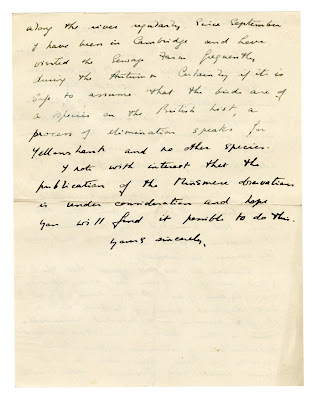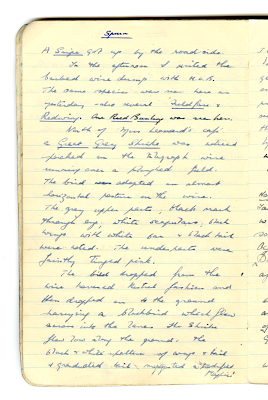%20photograph%20of%20Eva.png) |
| Photograph of Eva Crackles bird watching [U DEC 1998/05/18/164] |
Florence Eva Crackles (known as Eva), born in Hull in 1918, is a well-known figure that many would associate with botany, that branch of science that studies the biology and ecology of plants. Indeed, Eva spent much of her life dedicating herself to research and writing in this field, culminating in the publication of her extensive 'Flora of the East Riding' in 1990. Eva’s interest in botany, though persistent throughout her life, started to really blossom after 1950; before this, her enthusiasm for natural history focused more on ornithology, the study and observation of birds.
I’ve recently been rooting through the uncatalogued papers of Eva Crackles, which are held at Hull History Centre, as part of a placement I am undertaking related to my PhD research on Spurn Point. One of the first and most exciting things I discovered was a box full of Eva’s ornithology journals, detailing journeys taken across Yorkshire and elsewhere in the 1940s and 50s, and the remarkable diversity of bird species that she saw. As well as these journals, the Eva Crackles collection contains correspondence between Eva and different ornithologists, draft versions of presentations given on birdwatching and study, and piles of notes, drawings and photographs relating to bird anatomy, identification and behaviour.
Today, birding is an increasingly popular pastime, and as we better understand how getting outside into nature is beneficial for our physical and mental wellbeing (Hunt 2025), I think that learning a bit more about the early ornithological experiences of one of Yorkshire’s best-known naturalists is more relevant than ever.
Birding: art or science?
In a draft of a talk given at the Bird Club that she set up when teaching Biology at Cambridgeshire High School for Boys in 1947, Eva notes the many different activities involved in the scientific study of birds, such as observing, recording, theorising, and so on. Interestingly, she then offers a description that comes across as a bit less ‘scientific’:
But bird study has another appeal to me too. Do you like to stand in an art gallery and enjoy gazing at masterpieces, pictures of Vincent van Gogh, landscapes by Constable – perhaps at skeins of Geese flying over some lonely marsh by Peter Scott – and just steep yourself in the atmosphere captured by the artist? I gain that kind of satisfaction from my bird watching. (U DEC 1998/05/18/161)
%20Bird%20Study%20p2.tif) |
| Extract from the draft of a talk given by Eva, 1947 [U DEC 1998/05/18/161] |
There is a series of most beautiful pictures waiting to be discovered. Some still peaceful scenes – perhaps Dunlin standing on one leg with his bill tucked under his scapulars [feathers covering the base of the wing]. But many scenes full of vitality – a series of moving pictures – a Fulmar Petrel circling with straight motionless wings by some chalk cliff; a Green Woodpecker feeding on an ant hill, his red head flashing as it meets the sun’s rays; a Goldfinch fluttering over some thistle head and showing the gold banded black wing to good advantage. Then there are sound pictures too in the gallery of my memory. (U DEC 1998/05/18/161)
This combination of the scientific and personal is also evident in the birding journals that Eva kept from the late 1930s to the mid-1950s. The first of these begins with a brief section summarising her experiences of birding while studying at University College, Hull, when she lived at Thwaite Hall in Cottingham. The entries for these early years are rather precocious, suggesting her growing excitement and curiosity for the study of birds. She describes how, “in the precincts of Thwaite […] two of us […] experienced the joy of watching the feathered folk go about this daily business. We practised the art of moving quietly and waiting patiently. We were rewarded by learning a little about the habits, particularly at nesting time of some of the common British birds” (U DEC 1998/05 Box 1). The journals reveal a journey that takes us from Eva learning these fundamental bodily practices key to birding – patience, silence, and so on – to the honing her skills of recording, identification and description, which developed alongside her formal scientific education at the university.
 |
| Extract from one of Eva's journals, 1930s [U DEC 1998/05 Box 1] |
Eva’s birding journeys
Later journals reveal how Eva would travel far and wide to observe and study birds, visiting popular birding locations such as Skokholm in Wales and Flatford Mill in Suffolk, though she would most frequently visit places in East Yorkshire like Bempton Cliffs, Hornsea Mere, and Spurn Point. In October 1946, for instance, she stayed at Spurn for several days, filling her time by taking walks round the peninsula and observing a range of common and rarer birds. These walks were often taken with significant figures in the history of Spurn, such as George H. Ainsworth, a co-founder of the Spurn Bird Observatory (SBO), and H.O. Bunce, who was, among other things, the Yorkshire Naturalists’ Union bird recorder from 1960 to 1974 (and with whom Eva describes ascending the lighthouse at Spurn Point and watching as birds would crash into the windows, be picked up and ringed, and then let go!).
A long entry on the 27th October 1946 provides a great example of Eva’s enthusiasm for birds during this period. She recounts spotting a Great Grey Shrike, a large predatory songbird, perching on a telegraph wire outside Blue Bell Cottage, and she notes in detail its characteristics and behaviours: “the bird adopted an almost horizontal posture on the wire. The grey upper parts; black mark through eye; white scapulars; black wings with white bar and black tail were noted” (U DEC 1998/05/1/9). The bird then “dropped from the wire, hovered kestrel fashion and then dropped to the ground, harrying a blackbird which flew across into the lane” (U DEC 1998/05/1/9), and after watching for some time, she runs off to tell Bunce, who only manages to catch a glimpse before the Shrike flies off and disappears.
 |
| Entry from one of Eva's journals, 27 Oct 1946 [U DEC 1998/05/1/9] |
The journals relate visits to places even closer to home, too. The same journal explains how on 7th December 1946, Eva had intended to catch the bus to Spurn, but a message came through from George Ainsworth (of the SBO) to let her know that a party of Waxwings had been spotted on Tween Dykes Road in East Hull. She cycles there as fast as possible, setting up to observe them despite low visibility. What follows are a number of pages of careful observations on the features and behaviours of the birds – she notes their crests, plumages and feeding behaviours (apparently, they swallow berries whole). Ever the keen photographer, she sets up a tripod on a branch that appears especially popular with the Waxwings and waited for one to land, describing how two became “so indifferent to [her] presence” that they “passed within a foot or so of [her] head” (U DEC 1998/05/1/9).
 | |
| Entry from one of Eva's journals, 7 Dec 1946 [U DEC 1998/05/1/9] |
Far be it from me to be adamant concerning the identification of a species of which I have no previous experience […]. However, we are all agreed that the 3 birds were of a species not seen before or since by any of us. As you know we all had excellent views of the birds and on the first occasion I approached remarkably close to them. Also I have had excellent opportunities of studying waders. Until recently I have been able to visit Spurn Point and favourite wader haunts along the river regularly. (U DEC 1998/05/6)
 |
| Copy letter written by Eva, 27 Dec 1948 [U DEC 1998/05/6] |
Eva refers here to her already-extensive experience, particularly relating to wading birds, in order to prove her qualifications for identifying this unlikely visitor. The letter mentions that it was “a pity” that the birds had disappeared by the time a Mr ‘D. Ennion’ turned up – it’s not insignificant, either, that Eva and her friends were all women operating within a field that was at that point still dominated by men of a higher social class, and thus had to work harder to be taken seriously as natural historians.
From birds to botany
Later entries in the journals slow down somewhat, and we can find an answer as to why this is in Eva’s series of ‘Personal recollections’ published in the Bulletin of the Yorkshire Naturalists’ Union in the mid-1990s, copies of which are in the Eva Crackles collection. She moved back to Hull from Cambridge in January of 1950 to take a job at Malet Lambert High School, and in late March of that year, cycling home from school, a black cat ran in front of her bike and caused her to dive headfirst over her handlebars – “not a recommended activity!”. The resulting concussion meant she was unable to travel very far to engage in field research.
%20Personal%20recollections%201950s%20p1.png) |
| Extract from 'Personal Recollections 2, The Nineteen Fifties', written by Eva, 1995 [U DEC 1998/5/8/71] |
But even before this, she explains that birdwatching, “which was of necessity somewhat at random, was no longer satisfying. What I did not want was a rarity hunt or a mere list ticking exercise. I had tried to study bird behaviour but it was impossible to get continuity of observation given my personal circumstances” (Crackles 1995; U DEC 1998/5/8/71; emphasis added). It seems then that she was becoming disillusioned with the competitive nature of birding, and was instead looking for something where she could sate her interest in natural history more readily.
These two events pushed her to begin poking around the bombsites in Hull, where new and unexpected plant species were establishing themselves in the disturbed ground. In a way, the combination of the incident with the black cat and this loss of enthusiasm for birding were two important catalysts for one of the most consequential careers in botany in both Yorkshire and the UK more widely. But, despite moving away from birding and more into the world of plants, the skills that Eva honed – her ability to watch and observe, her keen eye for detail, an aptitude for recording – as well as the connections, friendships and memories she made evidently remained significant for the remainder of her career and her life.
%20photograph%20of%20Dunlin.png) |
| Photograph showing Dunlin in the air at Spurn, Sep 1947 [U DEC 1998/05/18/168] |
References
Hunt, E. 2025, ‘How to become a birder: 10 easy ways to start this life-changing hobby’, The Guardian. 19 June. Online at: https://www.theguardian.com/environment/2025/jun/19/how-to-become-a-birder-10-easy-ways-to-start-this-life-changing-hobby [Accessed 19 June 2025].
Toby Horkan
PhD Researcher in English, Centre for Water Cultures (University of Hull)

%20Bird%20Study%20p1.tif)




No comments:
Post a Comment
Comments and feedback welcome!